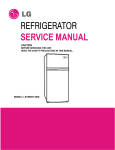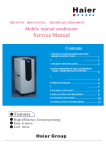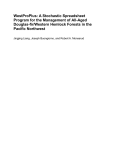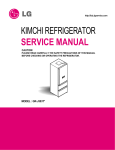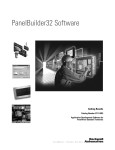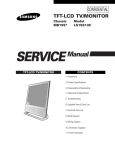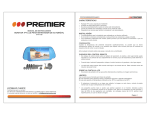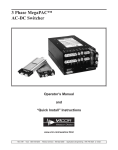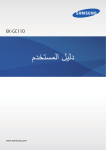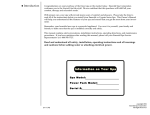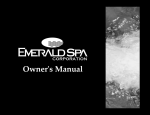Download kimchi refrigerator service manual
Transcript
http://biz.lgservice.com KIMCHI REFRIGERATOR SERVICE MANUAL CAUTION PLEASE READ CAREFULLY THE SAFETY PRECAUTIONS OF THIS MANUAL BEFORE CHECKING OR OPERATING THE REFRIGERATOR. MODEL : GR-K192AF Safety regulations 1. First check if there is any electric leakage in the refrigerator unit. 2. Always unplug the refrigerator before handling any electricity conducting parts. 3. When testing the refrigerator with the power on, use insulated gloves for safety. 4. When using measuring instruments, check the rated current, voltage and capacity. 5. Do not allow water or moisture to get into the mechanical or electrical parts of the refrigerator. 6. Remove all things on top of the refrigerator before tilting it during repairs to avoid spills. Be especially careful for thin objects (glass sheet, book). 7. When the refrigerating cycle is damaged, always request service to the major repair service agency. (This is to prevent the house from getting dirty from the gas within the cycle.) 8. Always double check for repairs related to safety to ensure customer safety. Contents 1. Safety warnings and cautions .......................................................................................................................3 2. Product specification .....................................................................................................................................6 3. Product installation method ..........................................................................................................................7 4. Circuit diagram ...............................................................................................................................................8 5. MICOM function and circuit description.......................................................................................................9 6. Freezing cycle and refrigerant.....................................................................................................................31 7. General details about the product ..............................................................................................................33 8. Major repair method for freezing cycle.......................................................................................................35 9. Characteristics of each part ........................................................................................................................44 10. Cautions for disassembling the product ..................................................................................................52 11. Assembly diagram and service parts list .................................................................................................53 -2- Safety warnings and cautions Chapter 1. Safety warnings and cautions u Always observe the ‘Safety Warnings’ and ‘Cautions’, which hare intended to ensure safety while repairing or operating the product. u Precautions are classified into ‘Warning’ and ‘Caution’, as explained below. w Warning Warning means a dangerous condition which could result in significant damage, injury or death if the instructions are not followed. w Caution Caution means a condition which could result in damage or injury if instructions are not followed. w Warning Use caution to prevent electric shock Do not allow the consumer to repair, disassemble or modify the refrigerator. The control panel (main PCB) uses 310V. When replacing PCB parts, wait at least 3 minutes after unplugging. Always unplug the refrigerator before repairing. Damaged power plug can cause fire or electric shock. Make sure that the power plug is not pressed by the back of the refrigerator Use a dedicated circuit. Overloading circuits or outlets could cause a fire. Power plug may be damaged and cause a fire or electric shock. -3- Safety warnings and cautions w Warning This product should always be grounded, when needed. Do not store flammable liquid or gas in the refrigerator such as ether, benzene, alcohol, medicine, LP gas etc. If you think that there is a possibility of electricity leakage by water or moisture, always ground the unit. It can cause an explosion or a fire. Grounding screw Grounding line Copper plate Ether More than 7 Do not store medicine or academic material etc. in the refrigerator. Ben zene LP gas When disposing the refrigerator, remove the rubber packing on the door and do not leave it where children play. Store an object that requires precise temperature control can cause deterioration in quality or unexpected reaction to cause a dangerous situation. A child can be dangerously entrapped in the refrigerator. Do not set items, particularly flower vase, cup, cosmetic or medicine on top of the refrigerator. Do not stack items or carelessly store food on the refrigerator. Items stored on the refrigerator could fall and cause injury. It can cause fire and electric shock or cause an injury from dropping. -4- Safety warnings and cautions w Caution When using the refrigerator for low temperature in freezer or refrigerator, do not store bottles. Always use exact replacement parts. Make sure that the model name, voltage, current and temperature ratings are correct for the electric part. Bottles can freeze and cause the bottles to crack, which can cause an injury. During repairs, be sure all connectors are tight and wires are properly routed. Do not bend, modify, bend, pull or twist the power cord. Make sure the connectors of the housing part are properly connected. It can cause fire or electric shock. During repairs, remove all dust and foreign material from the housing part, connector part and check part. Allow at least 5 minutes for resetting if you unplug the refrigerator. If can cause an overload to the condenser operation and cause problems. It can prevent problems such as tracking or short circuit. After 5 minutes -5- Product specification Chapter 2. Product specification 2-1. GR-K192AF GR-K192AF Item SPEC Volume External dimensions Usable volume 188.8Li Left compartment 94.3Li Right compartment 94.3Li Width 922mm Depth 699mm Height 883mm Total weight 66kg Motor power consumption 115W Direct cooling Cooling method Electronic Store/Season CYCLO PENTANE Insulation material 1 pc. Fresh vegetable basket 6 pcs. (6 large) Kimchi refrigerator container 2 pcs. Low temperature catalytic deodorizing system Freeze cycle Compressor NR58LBQH Evaporator PIPE ON SHEET R134a(145g) Refrigerant (amount) FREOL@15G(210cc) Oil Electrical part rating PTC P6R8MB OLP 4TM412TFBYY ø110,3 blades attached Fan motor for compressor cooling Left compartment seasoning heater 115V / 80W(Resistance:605Ω) Right compartment seasoning heater 115V / 80W(Resistance:605Ω) Capacitor (running) 250VAC 10µF Capacitor (starting) 200VAC 50µF -6- Product installation method Chapter 3. Product installation method 3-1. Method to adjust height of refrigerator ■ First adjust the level of the refrigerator. (If the floor is uneven, the refrigerator may vibrate or cause noise.) Horizontal adjustment leg (lower handle part) u Adjust the front to be leveled by turning the height adjustment screws under the front corners in the arrow direction. 3-2. Grounding method Plug the cord into a 115V grounded outlet. If you are unsure of the voltage or grounding integrity, consult a qualified electrician. Caution Grounding line Take care not to ground the circuit at one of the following places: 1. Water pipe: If there is a plastic piping within the system, the ground may not be valid. 2. Gas pipe: There is a danger of fire or explosion. 3. Phone line or lightning rod: If lightning strikes, dangerous voltage may be induced in the circuit. -7- Copper plate More than 75cm Circuit diagram Chapter 4. Circuit diagram -8- MICOM function and circuit description Chapter 5. MICOM function and circuit description 5-1. Function description 5-1-1. Display part Kimchi srore Notch Temperature Vegetable/Fruit Light freezing Freezing food Min Mid Max Min Mid Max Min Mid Max Min Mid Max 0°C -1.0°C -2.0°C 3.5°C 2.5°C 1.5°C -4.0°C -5.0°C -6.0°C -5°C -18°C -21°C 1. When the power is connected for the first time, it is set to “Lock”, “Left compartment-Cabbage Kimchi-Mid” and “Right compartment-Cabbage Kimchi-Mid”. 2. During a power shut-down or when the power is reconnected, the refrigerator maintains the prior display. But in case of a power-shut down or power reconnection during rhythm fermenting, the temperature returns to “Mid” for the applicable food type. 3. In “Lock” status, you will not hear a buzzer even when you press the buttons and the functions will not work. -9- MICOM function and circuit description 5-1-2. Food storage/seasoning function (1) When selecting food type and storing temperature 1. Press the “Lock/Unlock” button for more than 2 seconds to switch to “Unlock” status. 2. Press the “Kimchi store” button to select “Mid” ’ “Max” ’ “Min” ’ “Mid”, “Vegetable / Fruit” button “Mid” ’ “Max” ’ “Min” ’ “Mid”, and “Feezing” button “Normal” ’ “Max” ’ “Ligth Freeaing” ’ “Normal” in sequence 3. Press the “Lock/Unlock” button to complete the selection of food type and storing temperature. At this time, if a minute passes without pressing the “Lock/Unlock” button, it will automatically switch to Lock status and end the food type and storing temperature selection mode. (2) When selecting rhythm fermenting (seasoning) 1. Press the “Lock/Unlock” button for more than 2 seconds to switch to “Unlock” status. 2. At this condition, press “Fermentation” button to select “Normal ” ’ ”Normal ” ’ ”More ” ’ ”Underground Fermentation ” ’ ”Less ” ’ ” Less ” ’ ” Normal ” in sequence, and when the fermentation type is changed from “Less” to “Normal”, the food type is selected by the order of “Cabbage kimchi” ’ ”Radish kimchi” ’ ”Broth kimchi” in sequence. However, “Underground Fermentation ” is only for “Cabbage kimchi.” 3. Press the “Lock/Unlock” button to complete the rhythm fermenting (seasoning). At this time, if a minute passes without pressing the “Lock/Unlock” button, it will automatically switch to Lock status and end the rhythm ferment (seasoning) selection mode. 4. When “Rhythmic fermentation” is terminated, the remaining time is displayed, and when the fermentation is completed, “0 hour” is displayed as the remaining time and the storing temperature is automatically set to “Mid (3) When selecting flavor keeping 1. Press the “Lock/Unlock” button for more than 2 seconds to switch to “Unlock” status. 2. Select “Kimchi store” as storing type. (Flavor keeping function is only limited to “Kimchi store”) 3. At this time, press the “Flavor keeping” button to select or cancel the flavor keeping function. 4. Press the “Lock/Unlock” button to end the flavor keeping selection mode. At this time, if a minute passes without pressing the “Lock/Unlock” button, it will automatically switch to Lock status and end the flavor keeping selection mode. 5. If you select flavor keeping during seasoning process, it will immediately end the seasoning and switch to flavor keeping. At this time the storing temperature will automatically be set to “Mid”. 6. If you select the flavor keeping function, the refrigerator will lower the temperature to maintain the current Kimchi flavor. (-1 degrees for “Min”, -0.5 degrees for “Mid” and -0 degrees for “Max”.) 7. During flavor keeping operation, a cold shock operation is done every 12 hours. 8. If you select rhythm fermenting during flavor keeping, the flavor keeping function will be canceled. - 10 - MICOM function and circuit description 5-1-3. When selecting power on/off function 1. Press the "Lock/Unlock" button for more than 2 seconds to switch to "Unlock" status. 2. At this time, press the "Power" button for more than 2 seconds to turn the power off. 3. At this time, all the LEDs in the display will be turned off with the power off LED turning on. 4. If you press the "Power" button when the power is off, it will turn on the power and recover to "Cabbage Kimchi" and "Mid". 5. When the power is turned off, the heater of the applicable compartment is turned off and the valve will be closed. 5-1-4. Rhythm fermenting control pattern diagram 1. The fermenting control pattern varies, depending on the temperature of the Kimchi when it is placed into the storage, the type of Kimchi being made and the degree of the seasoning selected. 2. In the 1st seasoning cycle, if the Kimchi is at room temperature, the cold control operates. 3. During the seasoning cycle, if the Kimchi is cold, the seasoning heater is turned on and if the Kimchi is warm, the seasoning heater is turned off.(Only 1st seasoning and 2nd seasoning) 4. If a failure occurs, such as a sensor error during seasoning, the storage will default to Cabbage Kimchi storage status. : Seasoning heater ON/OFF : Seasoning heater OFF 5℃ 1.0 ℃ -0.5 ℃ -2.0 ℃ the Kim place chi d is at r in the refrig oom te e mpera rator ture 18 ℃ (Broth Kimchi: 10 ℃) When t the re he Kimchi p friger ator is laced in c ool When Kimchi sensor temperature Time Storage operation 1st seasoning 2nd seasoning 3rd seasoning Seasoning start 4th 5th seasoning seasoning Seasoning complete - 11 - MICOM function and circuit description 5-1-5. Temperature control method 1. The compressor runs or stops and the 3-way valve opens or closes depending on the temperature sensed in the left and right compartment. 2. If the temperature in either compartment is unsatisfactory, the compressor is turned on and the 3-way value is opened to the affected compartment. 3. If the temperature in both compartments is unsatisfactory, the compressor is turned on and runs until both compartments become satisfactory. The 3-way valve is opened and closed to each compartment alternatively until the temperature is satisfactory. 4. During the seasoning cycle, if the temperature is low, the heater is turned on and if the temperature is high, the compressor is turned on and the 3-way value is opened. Left compartment temperature Right compartment temperature 3-Way valve position COMP Satisfactory Satisfactory Note 1) g OFF Satisfactory Unsatisfactory Right compartment ON Unsatisfactory Satisfactory Left compartment ON Unsatisfactory Unsatisfactory Left 20 min/Right 20 min ON Note1) When the temperature is satisfactory in both compartments, the 3-way valve is open to whichever compartment that has had a satisfactory temperature most recently. ■ Summary chart of COMP and 3-Way valve operation Left compartment sensor Temperature unsatisfactory Right compartment sensor Temperature satisfactory Left compartment 3-way valve OPEN CLOSE Right compartment 3-way valve OPEN CLOSE ON COMP OFF 5-1-6. Buzzer sound When you press a button on the front display, you will hear a varying buzzer sound depending on the type and function. (Refer to Buzzer operating circuit in p21). 5-1-7 Power failure compensation function 1. When the power is restored after an outage, the refrigerator performs the setting originally programmed except for Error status and Test mode. 2. If the power fails during the seasoning process, there is not power outage compensation function and the storage defaults to previously set Kimchi type and temperature of "Mid". (to protect excessive seasoning) - 12 - MICOM function and circuit description 5-1-8. Operation in response to ambient temperature The storage senses the ambient temperature and adjusts the temperature in the compartments accordingly. This keeps the storage from being too cold or too warm because of seasonal variations and maintains exact temperatures in the compartments. In general operation Storage temperature of the left and right compartments Operation in response to the ambient temperature Season Spring Summer Autumn Winter 5-1-9. Sequential operation of components Components (compressor, 3-way valve and left/right seasoning heater) are operated in a specific order to prevent damage and noise caused by simultaneous operation of all parts when the unit is started and after completing the self-test routine. Operation status Operating order Immediately Temperature of the left of right sensor is >45°C Power on 3 min 10 sec 3-way valve left open 3-way valve open Initial power-up Immediately 0.5 sec Temperature of the left of right sensor is <45°C Power on Left seasoning heater on Remarks Compre ssor on 5 sec Right seasoning heater on 3 sec 0.5 sec Left seasoning heater off 3 min 10 sec 7 min Compressor on loads When returning to normal status in test mode off 3 sec Compressor on 3-way valve left open 3-way valve open All Right seasoning heater off 3 min 3-way valve open 3-way valve left open g Operation order may slightly vary depending on temperature setting. - 13 - The 3-way valve is opened to both compartments for 3 minutes; then it is opened to either the left or the right compartment, depending on the temperature in the compartments. MICOM function and circuit description 5-1-10. Error diagnosis function 1. The error diagnosis function is the function to support SVC in case of an error that can affect the performance of the product. 2. If an error occurs, the control panel button will not work. 3. If an error occurs and is resolved, the refrigerator will default to the normal status. (The unit is reset.) 4. The error codes are shown in segment for the remaining seasoning time display of the right compartment, and all LEDs, except for failure code, are turned off. NO Item Error code display Error contents 1 Failure of left compartment sensor (R1). Displays "E1" on the seasoning remaining time part Left compartment lid sensor disconnected or short circuited 2 Failure of right compartment sensor (R2). Displays "E2" on the seasoning remaining time part Left compartment lid sensor disconnected or short circuited 3 Failure of ambient temperature sensor (RTS) 4 Communications error In case of an ambient temperature sensor error, the error code is not displayed and press the left and right compartment "Store" buttons for more than 1 second when checking the LED. When communication is not working continuously for 30 sec Only LED for "E1" and "E2" was on Note 1) The failure code is not displayed for the outside temperature sensor failure, but for ‘LED CHECK’ (by pressing and holding “Kimchi store” button on the left chamber and “Kimchi store” button on the right chamber together for one second or longer). If the outside temperature sensor is normal, all LEDs are turned ON, but if abnormal, all LEDs are turned ON with the remaining time display on the right chamber OFF. - 14 - MICOM function and circuit description 5-1-11. Test function 1. The test function checks the functions of the PCB and the refrigerator, searching for errors in parts. 2. The test switch on the PCB operates the test mode. The refrigerator reverts to the normal mode after 2 hours if you forget to end it manually. 3. When the test mode is active, the buttons on the control panel are disabled but the buzzer still sounds a ding if one is pressed. 4. When the test mode is completed, unplug the refrigerator briefly and plug it in again to reset it and allow normal operation. 5. If a sensor failure or other failure is detected during the test mode, release the test mode to display the failure code. 6. During the display of the error code, test mode does not work even if you press the Test switch. Mode Operation COMP fan motor VALVE Left and Right DIAPLAY LED Remarks seasoning heater TEST1 Press the test switch once ON Left compartment 20minute / Right compartment 20 minute OFF Error code display “11” This test checks the refrigeration system for the left and right compartments. TEST2 Press the test switch once when Test 1 indicates it is completed. ON Right compartment valve OPEN OFF Error code display “22” This test checks the refrigeration system for the right compartment only. TEST3 Press the test switch once when Test 2 indicates it is completed. ON Left compartment valve OPEN OFF Error code display “33” This test checks the refrigeration system for the left compartment only. TEST4 Press the test switch once when Test 3 indicates it is completed. OFF ON Error code display “44” This test checks the seasoning heaters. Normal Press the test recovery switch once when Test 4 indicates it is completed. After a maximum of 30 minutes or when the temperature of the compartments is higher than 40C , the storage will default to its initial status. The compressor operates after a delay of 7 minutes. LED CHECK function All LEDs are turned ON by pressing and holding “Kimchi store” button on the left chamber and “Kimchi store” button on the right chamber together for one second or longer. When these buttons are released, the LED returns to the previous state. - 15 - MICOM function and circuit description 5-2. Circuit description 5-2-1. Power circuit The power circuit consists of the noise attenuation part and the SMPS (Switch Mode Power Supply) part. The SMPS consists of the rectifier (BD1 & CE1) to convert AC voltage to DC voltage, switching part (IC3) to switch the converted DC voltage, transformer to transmit energy of the first side of the switching end to the second side, the secondary power to supply power to MICOM and IC, and the feedback part (IC4) to feedback the secondary voltage to the first side of the transformer in order to maintain the secondary voltage constant. Caution : High voltage (DC 310V) is maintained in this circuit. Wait at least 3 minutes after unplugging to allow the current to dissipate. There is a danger of electric shock. 5-2-2. Oscillation circuit The oscillation circuit provides the clock signal for synchronization and calculation of time in relation to the logic elements of microprocessor IC1 (MICOM). OSC1 must always use the original rated parts, because if the specification changes, the timing generated will not be correct, causing erratic functioning of the microprocessor. 5-2-3. Reset circuit The reset circuit allows the entire process to be started from the initial status by resetting the various elements within the MICOM (IC1), such as RAM, whenever power is applied to the unit. Low voltage is applied to the reset terminal for 10ms at the beginning of the power input. The reset terminal has a voltage of 5 V during general operation. (If the reset operation fails, the microprocessor will not operate.) - 16 - MICOM function and circuit description 5-2-4. Load/Buzzer driving circuit (1) Load driving circuit Type of load COMP. fan motor Left seasoning heater Right seasoning heater Measuring point (IC7) 13 10 11 Status ON Within 1V OFF 12V (2) Buzzer driving circuit (located on display PCB) g Only the buzzer sound for the Lock/Unlock operation is shown in this SVC technical manual. LED MODULE TYPE 49 P15 (INT1) 48 P14 (PWM3/TC3/PDO3) Status Measuring point Ex) Lock: "Ding-D-Dong" sound 45ms 45ms 45ms 45ms 70ms IC101 (Pin 3/61) Ex) Lock: "Ding-D-Dong" sound 45ms 45ms 45ms 45ms 70ms 750ms 5V 5V 0V 0V 5V 5V IC101 (Pin 2/62) 0V 1046.5Hz 1174.7Hz 0V 1318.5Hz - 17 - Off 750ms 5V 0V 1568.0Hz 1318.5Hz 1046.5Hz MICOM function and circuit description 5-2-5. Switch input circuit The following circuit is the input circuit to detect the test switch signal to check the refrigerator. 5-2-6. Temperature sensor circuit The following temperature sensor circuit consists of a sensor to detect the outside (ambient) temperature and sensors in the left and right compartments for storing and seasoning Kimchi. The status of each sensor, whether open or shorted, is shown below. Sensor Check point Left compartment sensor POINT A Voltage Right compartment sensor POINT B Voltage Outside sensor POINT C Voltage - 18 - Normal(-30°C~50°C) Shorted Open 0.5V~4.5V 0V 5V MICOM function and circuit description 5-2-7. Stepping motor operation circuit (3-way valve) u The motor is operated by sending out "High" and "Low" signals as many as the designated number of steps through MICOM Pin 15, 16, 17, 18 to rotate the motor through the magnetic field formed by the motor and the coil wrapped around each stator. 5-2-8. Power failure compensation circuit (located on display PCB) u The power failure compensation circuit recalls the temperature range of the right and left compartments and maintains these levels if power if interrupted briefly. The IC for power failure compensation (EEPROM) delivers to and maintains the information in MICOM through the serial interface. - 19 - MICOM function and circuit description 5-2-9. Storing temperature compensation and over-cool/under-cool cut compensation circuit (1) Storing temperature compensation u This is the circuit to input the temperature compensation level required for adjusting storage temperature at the left or right compartment. Left compartment Right compartment Temperature Remarks compensation value (RCL) (RCR) 180 KΩ +2.5 ˚C 56 KΩ +2.0 ˚C 33 KΩ +1.5 ˚C 18 KΩ +1.0 ˚C 12 KΩ +0.5 ˚C 10 KΩ 0 ˚C Warmer Standard temperature 8.2 KΩ -0.5 ˚C 5.6 KΩ -1.0 ˚C 3.3 KΩ -1.5 ˚C 2 KΩ -2.0 ˚C 470 Ω -2.5 ˚C Cooler u Temperature compensation table by adjustment of resistance value (difference against current temperature) Ex) If you change the resistance of compensation at the left compartment (RCL) from 10KΩ (current resistance) to 18KΩ (adjusted resistance), the storage temperature in the left compartment will be increased by 1°C. Classification Left compartment (RCL) Modified resistance Current resistance 470 Ω 2 KΩ 3.3 KΩ 5.6 KΩ 8.2 KΩ 10 KΩ 12 KΩ 18 KΩ 33 KΩ 56 KΩ 180 KΩ 470KΩ No change 0.5°C UP 1°C UP 1.5°C UP 2°C UP 2.5°C UP 3°C UP 3.5°C UP 4°C UP 4.5°C UP 5°C UP 2 KΩ 0.5°C DOWN No change 0.5°C UP 1°C UP 1.5°C UP 2°C UP 2.5°C UP 3°C UP 3.5°C UP 4°C UP 4.5°C UP 3.3 KΩ 1°C DOWN 0.5°C DOWN No change 0.5°C UP 1°C UP 1.5°C UP 2°C UP 2.5°C UP 3°C UP 3.5°C UP 4°C UP 5.6 KΩ 1.5°C DOWN 1°C DOWN 0.5°C DOWN No change 0.5°C UP 1°C UP 1.5°C UP 2°C UP 2.5°C UP 3°C UP 3.5°C UP 8.2 KΩ 2°C DOWN 1.5°C DOWN 1°C DOWN 0.5°C DOWN No change 0.5°C UP 1°C UP 1.5°C UP 2°C UP 2.5°C UP 3°C UP 10 KΩ 2.5°C DOWN 2°C DOWN 1.5°C DOWN 1°C DOWN 0.5°C DOWN No change 0.5°C UP 1°C UP 1.5°C UP 2°C UP 2.5°C UP 12 KΩ 3°C DOWN 2.5°C DOWN 2°C DOWN 1.5°C DOWN 1°C DOWN 0.5°C DOWN No change 0.5°C UP 1°C UP 1.5°C UP 2°C UP 18 KΩ 3.5°C DOWN 3°C DOWN 2.5°C DOWN 2°C DOWN 1.5°C DOWN 1°C DOWN 0.5°C DOWN No change 0.5°C UP 1°C UP 1.5°C UP 33 KΩ 4°C DOWN 3.5°C DOWN 3°C DOWN 2.5°C DOWN 2°C DOWN 1.5°C DOWN 1°C DOWN 0.5°C DOWN No change 0.5°C UP 1°C UP 56 KΩ 4.5°C DOWN 4°C DOWN 3.5°C DOWN 3°C DOWN 2.5°C DOWN 2°C DOWN 1.5°C DOWN 1°C DOWN 0.5°C DOWN No change 0.5°C UP 180 KΩ 5°C DOWN 4.5°C DOWN 4°C DOWN 3.5°C DOWN 3°C DOWN 2.5°C DOWN 2°C DOWN 1.5°C DOWN 1°C DOWN 0.5°C DOWN No change ƒU Right compartment (RCR) - 20 - MICOM function and circuit description (2) Over-cool/Under-cool cut compensation Left compartment cut compensation Over-cool compensation Under-cool compensation JCL1 JCL2 CUT CUT Right compartment cut compensation Left compartment storing temperature compensation Over-cool compensation Under-cool compensation JCR1 JCR2 +1°C CUT -1°C CUT 0°C CUT CUT 0°C (Factory default) Right compartment storing temperature compensation +1°C CUT -1°C CUT 0°C 0°C (Factory default) u The cut compensation circuit compensates the storing temperature of the left or right compartment by simply cutting it out of service for a brief period. - 21 - MICOM function and circuit description 5-2-10. Communication circuit between main PCB and display PCB This circuit provides communications between the MICOM on the main PCB and the MICOM of the display PCB. If there is no communication between these boards for 30 seconds, a communication error occurs. MAIN PCB DISPLAY PCB DC 12V MAIN MICOM MICOM for LED control GND Send (Error status) Receive (Notch status) PWB(PCB) ASSEMBLY, MAIN PWB(PCB) ASSEMBLY, DISPLAY - 22 - MICOM function and circuit description 5-2-11. Button input and display part illumination circuit This circuit determines which buttons are pressed and drives the LED display, whose driving method is a scan method. - 23 - MICOM function and circuit description 5-3. Sensor resistance characteristics table Measuring temperature (°C) ` Left sensor, right sensor, outside sensor -20°C 77 KΩ -15°C 60 KΩ -10°C 47.3 KΩ -5°C 38.4 KΩ 0°C 30 KΩ +5°C 24.1 KΩ +10°C 19.5 KΩ +15°C 15.9 KΩ +20°C 13 KΩ +25°C 11 KΩ +30°C 8.9 KΩ +40°C 6.2 KΩ +50°C 4.3 KΩ u The tolerance of the sensor resistance is ±3%. u Measure the resistance value of the sensor after leaving it for more than 3 minutes (delay is required due to sensing speed.) u Always use a digital tester. Analog testers have a higher margin of error. u For left and right sensor, measure both sensor ends of the connector after separating the connectors of CON2 and 3 of PWB (PCB) assembly and main part. For the outside sensor, measure end of 2 and 5 of CON5. - 24 - MICOM function and circuit description 5-4. PCB parts diagram and parts list 5-4-1. PWB (PCB) assembly and main parts diagram (The parts diagram can slightly change according to the situation.) - 25 - MICOM function and circuit description 5-4-2. PWB (PCB) assembly and main parts list g The parts list can slightly change according to the situation. - 26 - MICOM function and circuit description 5-4-3. PWB (PCB) assembly and display parts diagram and parts list g The parts list can slightly change according to the situation. - 27 - MICOM function and circuit description 5-5. PCB circuit diagram 5-5-1. PWB (PCB) assembly and main circuit diagram g PCB circuit diagram can slightly change according to the situation. PWB(PCB) ASSEMBLY, MAIN - 28 - MICOM function and circuit description PWB(PCB) ASSEMBLY, DISPLAY (6871JB1462) - 29 - MICOM function and circuit description 5-5-2. PWB (PCB) assembly and display circuit diagram (6871JB1462) g The circuit diagram can slightly change according to the situation. g This includes the PWB (PCB) assembly and sub circuit diagram. - 30 - Freezing cycle and refrigerant Chapter 6. Freezing cycle and refrigerant 6-1. Freezing cycle (Freezing principle/Refrigerant gas circulation diagram) 6-1-1. Freezing principle Freezing is an operation of maintaining a lower temperature (generally 0°C) than the natural temperature (usually ambient temperature surrounding us). This requires an insulated space, refrigerant (R134a) to absorb the heat and the circulation circuit (compressor, condenser, evaporator etc.) to operate the phase change of the refrigerant. 6-1-2. Refrigerant gas circulation diagram 1. Compressor 2. Wire condenser 8 7 2-1. Hot line pipe 3. Drier 4. 3-way valve 5. Capillary tube (left) 6. Capillary tube (right) 7. Evaporator (left) 8. Evaporator (right) 5 9. Suction pipe 10. Cooling fan 6 4 2 -1 10 3 9 2 1 - 31 - Freezing cycle and refrigerant 6-1-3. Operation description of each circulation circuit No. Parts name Operation details Refrigerant gas condition (input and output) 1 Compressor Compress the refrigerant from low pressure (0kg/cm2) to high pressure (8-12kg/cm2). Low pressure gas-->High pressure gas (0kg/cm2) (8~12kg/cm2) Temperature (30°C) ¡ (80~120°C) 2 Condenser & hot line pipe High pressure gas refrigerant exhausts heat and becomes liquid refrigerant. High pressure gas-->High pressure liquid (8~12kg/cm2) (8~12kg/cm2) Temperature (80~120°C) ¡ (40~60°C) 3 Drier There is an absorbent that absorbs the moisture within the circulation circuit. (Moisture absorption device) 4 Capillary tube This is the long narrow pipe where high pressure refrigerant passes to reduce the pressure. High pressure liquid-->Low pressure liquid (8~12kg/cm2) (0kg/cm2) Temperature (40~60°C) ¡ (-27°C) 5 Evaporator Low pressure liquid refrigerant absorbs heat to change to low pressure gas refrigerant. Low pressure liquid-->Low pressure gas (0kg/cm2) (0kg/cm2) Temperature (-27°C) 6 Suction pipe This connects the evaporator and the compressor. Low pressure gas-->Low pressure gas (0kg/cm2) (8~12kg/cm2) Temperature (-27°C) ¡ (30°C) Caution u Because the outlet of the capillary tube is where the high pressure refrigerant changes from high to low pressure, the low pressure refrigerant quickly diffuses to the evaporator, making flash sounds. (shik shik sound) u When the low pressure liquid refrigerant evaporates from the evaporator, it is done throughout the whole pipe from inlet to outlet, making a sound of liquid refrigerant flowing. This can happen depending on the load condition of the refrigerator and on the evaporation, but it is not a problem. 6-2. Refrigerant Refrigerant R134a (HFC-134a) Characteristics Because it does not include chloride, which cause ozone destruction, it will not destruct the ozone and has a low GWP compared to the existing R12 (GWP: 15300). g ODP: Ozone Depleting Potential (Relative index with CFC11 as 1.0) GWP: Global Warming Potential (Relative index with CO2 as 1.0) - 32 - ODP GWP Remarks 0 1200 Refrigerant General details about the product Chapter 7. General details about the product 7-1. Refrigerator noise The structure of the freezing room and mechanical room, which are the sources of Kimchi refrigerator noise, is as follows. Here you can see that the main source of noise during refrigerator operation is the compressor, the condenser and the fan motor that cools the compressor in the mechanical room. (Fig. Diagram of Kimchi refrigerator noise source) 7-1-1. SVC method for noise claim (1) Basic method of noise reduction • Block: This method blocks the noise from the source so that it does not reach the ears by blocking the transmission path of the sound with high density sound blocker. (This is effective in high frequency area) • Using sound absorber: This method is similar to the blocking method but uses Styrofoam and glass wool in the transmission path to absorb the sound. (This is effective in low frequency area) • Vibration reduction: This method blocks the mechanical vibration from the operating part so that it does not reach other parts. (using vibration reduction rubber etc.) • Dynamic balance maintenance: This method minimizes the dynamic imbalance of the rotating object. • Fixing the vibrating part: This method firmly fixes the vibrating part depending on the situation. • Removing contact: Separate the two parts or firmly fix the object that periodically make sound by hitting each other. - 33 - General details about the product (2) Service method for major noise claim item for Kimchi refrigerator Noise claim Noise generation Service method Noise from poor installation u The installation floor surface is not hard enough u The refrigerator is not leveled • Reinforce the floor hardness • Move the installation location • Use the adjustment screw in front of the refrigerator to level the refrigerator Parts vibration u "Wing" sound • Insert firmly all the parts of the refrigerator in the right location Compressor resonance sound u "Woong Woong" sound • Reduce the noise by adjusting the pipe and seat rubber Compressor noise u Poor balance of the compressor u Contacting sound of the surrounding pipe of the compressor part • Adjust the surrounding pipe and seat rubber to maintain the level of the compressor • Remove contact Operating device noise u Contact sound from the OLP contact point during compressor operation • Exchange OLP Wire condenser noise (vibration noise) u "Woong Woong" sound u "Ching" sound • Recheck the screws • Remove the welding part of the heat plate (wire) and remove the heat plate Remarks u Mainly within the refrigerating compartment u "Tak Tak" 7-2. Details on power consumption The power consumption of the refrigerator is measured within the chamber where constant temperature and humidity is maintained. In the right figure, maintain the chamber to 30°C and 75% humidity with no load to the refrigerator and set the temperature of the left and right compartment to 3°C to measure the power consumption. The power consumption is calculated as follows. Accumulated power meter Constant temperature and humidity chamber (Temperature of 30°C and humidity of 75%) Refrigerator Product installation tray Monthly power consumption (kWh/month) = Measured value (kWh/day) x 365 days / 12 months Caution The actual power consumption and the one indicated on the refrigerator can differ due to the using condition. - 34 - Major repair method for freezing cycle Chapter 8. Major repair method for freezing cycle 8-1. Major repair work standard for refrigerator using R134a refrigerant No. Work item Unit 1 Opening time for pipe and piping parts Min 2 Welding work Nitrogen supply pressure 3 Refrig Vacuum erator time cycle Vacuum degree Vacuum part Vacuum piping Min Torr EA Pipe coupler EA Socket EA Plug EA 4 Refrigerator cycle Refrigerant measurement (BOMBE) 5 6 Work standard Objective Remarks Pipe part: Within 1 hour Compressor: Within 10 minutes Drier: Within 20 minutes Prevent moisture penetration Specially manage to half or lower of the prior standard during rain or rainy season. (Especially the water penetration within the piping can be crucial) Do the welding while supplying the nitrogen. (Nitrogen pressure: .1-0.2kg/cm2) Prevent oxidization - Refer to the Caution section of the major repair part for work methods of each part. scale generation within the pipe from - Because the R134a refrigerant has a smaller molecular size than that of R12 refrigerant, high temperature heat during welding special care is needed when welding the pipe because leakage can occur more easily. - Do not apply pressure to the parts of the piping before and after the welding. It can cause the pipe to crack and cause leakage. 40 minutes or more 0.03 Torr or below (reference) Simultaneous vacuum for high and low pressure Remove moisture Use manifold for R134a Model name: 40134A Manufacturer: US Robin Air For R134a Model name: PCV630-2SV 1EA Model name: PCV400-2PV 1EA Manufacturer: Japanese Nito For R134a Model name: 2SV For R134a Model name: 2PV Prevent mixed penetration of mineral oil and ether oil Prevent mixed penetration of R12 refrigerant Prevent mixed penetration of R12 refrigerant Prohibit mixed use of R12 refrigerant Use the one for R134a and the measurement tolerance is ±5g. Note) If it is -5g for winter and +5g for summer, it is well managed. (manufactured by LG) Prohibit mixed use of R12 refrigerant Exchange drier - For R134a - When repairing the refrigerator cycle piping, always exchange the drier. Remove moisture existing within the piping Leakage test - Never do a soap water test. The soap water can leak into the piping from the vibration. - Leakage detector model: 16170, 16500. Manufacturer: US Robin Air Detect refrigerant leakage part EA (for reference) - 35 - Manufacturer of 113l/min model WVP-Z: US Asco Note) The model should have a counter-current blocker. The vacuum effect can be increased during a vacuum with both high and low pressure while operating the compressor. For the refrigerant piping (rubber type), using the existing piping for R12 for the new R134a refrigerant can cause the rubber to be melted (can cause leakage). - When measuring the refrigerant, do not measure it in a very hot or cold location (ambient temperature of 25°C is best) When manufacturing an additional bombe, use copper for the material. - End socket: 2SV plug: Use the proper one for 2PV R134a Note) When welding the connection part of both ends, make sure the internal O ring (rubber) does not burn. - For the refrigerant leaking part, check if oil is leaked and if not found, use the electric leakage detector. Major repair method for freezing cycle 8-2. Introduction to major repair work Work sequence Major repair details Work tools Diagnose problem Remove residual refrigerant - Cut the end of the drier part (high pressure side) and compressor charging part to remove the refrigerant. Pliers, nipper Exchange and weld parts - Use the compressor, drier, oil and refrigerant for R134a. - For the parts with nitrogen sealing and vacuum wrapping, check the "pik" sound before assembling. Use only the ones with proper wrapping and immediately assemble and weld the parts. - When welding the parts always substitute the nitrogen. (nitrogen pressure: 0.1-0.2kg/cm2) - Major repair work should be done in a clean work space with no humidity. Pipe cutter, gas welder, nitrogen gas Welding rod (silver: IS430B, copper: BCup-2) Flux (Hydrux Korea) - Connect the hose and vacuum pump of the manifold gauge to the high pressure (drier part) and low pressure side (compressor refrigerant charging part), and make it vacuum for more than 60 minutes. - Vacuuming speed: 113/l/min Vacuum pump (for R134a), manifold gauge - Measure the bombe exclusively provided by LG for R134a within the regulated value ±5g using an electric weight and insert it to the refrigerant charging part of the compressor. (insert refrigerant while operating the refrigerator) - Weld carefully after pinching the charging part. Bombe for R134a (mass cylinder), refrigerant (R134a), manifold gauge, electric weight, punch off pliers, gas welder - Check for leakage in the re-welded parts • Minor leakage: Use the electric leakage detector • Major leakage: Use the naked eye or finger to check the oil from the compressor g Caution: Do not use soap water for the leakage parts Electric leakage detector, driver (+) Vacuum Charge refrigerant and weld the sealing Check the refrigerant leakage and cooling performance - Cooling performance check 1. Check whether the heat emitter is warm by hand. 2. Check if the moisture is formed evenly around the evaporator surface within the refrigerator. Arrange the mechanical room and tools Move and install - The flux of the silver welding part should be removed with soft brush or wet cloth etc. (Flux can accelerate rusting and cause leakage). - The tools for R134a should be wiped off well so that dust and moisture cannot be penetrated and kept in a clean tool box or specified location. - The installation after moving, should be done in accordance with the installation method of the major repair for the refrigerator. (Maintain a 5cm or more distance from the wall for the model with the cooling fan in the mechanical room.) - 36 - Brass brush, cloth, tool box. Major repair method for freezing cycle 8-3. Caution during major repair Item Caution 1. Using tools 1) Use the parts and tools for R134a. 2. Removing residual refrigerant 1) When removing the residual refrigerant always turn the refrigerator off and then wait for more than 5 minutes. (If you work before waiting 5 minutes, the internal oil can leak out.) 2) When removing the refrigerant, first cut the 1. high pressure side (drier part) with a nipper and secondly cut the 2. low pressure side to remove the residual refrigerant. (You must do it in this order. If this order is reversed a great amount of oil can leak out.) Evaporator Evaporator Drier Low pressure side 2 Condenser 1 High pressure 3-Way side Valve Hot Line Pipe 3. Exchanging drier 1) During piping repair and inserting the refrigerant, always use the drier for R134a. 4. Welding nitrogen substitute 1) To prevent the oxidization scale from forming within the pipe, weld it while substituting the nitrogen with a constant pressure within the piping. (nitrogen pressure: 0.1-0.2kg/cm2) 5. Others 1) Internal cleaning and sealing within the cycle pipe should be done with nitrogen gas or R134a refrigerant. 2) When checking for leakage, use the electric leakage detector. 3) When cutting the pipe, always use the pipe cutter. 4) Be careful not to let moisture penetrate within the cycle. - 37 - Major repair method for freezing cycle 8-4. Actual major repair work Item Caution 1. Removing residual refrigerant Evaporator Drier Low pressure side 2 High pressure 3-Way Valve side Condenser Key Point Maintain refrigerant removing order (Oil can leak from compressor) 1 Hot Line Pipe 1. When removing the residual refrigerant always turn the refrigerator off and then wait for more than 5 minutes. (If you work before waiting 5 minutes, the internal oil can leak out.) 2. When removing the refrigerant, first cut the 1. high pressure side (drier part) with a nipper and secondly cut the 2. low pressure side to slowly remove the residual refrigerant. 2. Nitrogen blowing welding (Welding nitrogen substitute) Evaporator Drier Low pressure side 2 High pressure 3-Way Valve side Condenser 1 Hot Line Pipe Key Point If you do not blow the nitrogen while welding, it can form oxidization scale and have a negative effect on product performance and reliability. Exchanging drier After assembling the drier, blow the nitrogen gas to the high pressure side (0.1-0.2kg/cm2) and do the welding on part 1 and 2. Exchanging compressor Blow the nitrogen gas to the low pressure side and then do the welding on part 1 and 2. Note) The heating time during welding for other parts is very short and the possibility of forming an internal oxidization scale is very low. Exclude the nitrogen blowing for other parts. - 38 - Major repair method for freezing cycle Item Caution 4. Vacuuming Evaporator Compressor 3 Drier High pressure 3-Way Valve side Condenser 2 1 Low pressure Blue High pressure Hot Line Pipe Yellow Red Key Point Vacuum pump - When vacuuming, connect the power to increase the vacuum effect. Connecting the pipe Connect the red hose to the high pressure side and the blue hose to the low pressure side. Vacuuming order Open valve 1 and 2 to vacuum for 40 minutes and then close valve 1. 5. Refrigerant charging Working order 1) After completing the vacuuming, check the refrigerant amount for each model. 2) Using the vacuum pump, make the bombe vacuum. 3) Measure the refrigerant charging amount - Using an electric weight, measure the weight of the vacuum bombe. - After charging the refrigerant in the bombe, calculate and measure the weight. - When sucking the refrigerant operate the compressor. (Inserting refrigerant is easier and surer.) Key Point - Room temperature must be around 25°C during the operation. - Control the refrigerant charging amount as follow; -5g in winter and +5g in summer. Indicates the weight of empty bombe Calculation of refrigerant charging amount Refrigerant amount=Weight after charging Weight before charging (Bombe weight) - 39 - Major repair method for freezing cycle Item Caution 5. Charging the refrigerant Evaporator Compressor Drier High pressure side be m Bo 3-Way Valve Condenser Hot Line Pipe 4) Charging the refrigerant: As shown above, operate the compressor and charge the refrigerant with the charging pipe. 5) When the charging is complete, pinch the charging pipe using the pinch-off plier. 6) After welding the end of the pinched charging pipe with copper, test for gas leakage on the welding part. 6. Testing for gas leakage Using an electric weight, test for leakage on welded parts and other parts that you think can leak gas out. 7. Arranging cycle piping of each part When the work is done, check whether all pipes are in its original position before closing the cover back-M/C. Especially maintain a distance (10mm) between the pipes so that it does not touch each other. 8-5. Basic principle for major repair 1) Follow the safety principles of handling gas. 2) Use a plate jig (or wet towel), if needed, to prevent any skin burn from wires during welding. (to ensure insulation is not damaged, to prevent safety accidents and to ensure product safety.) 3) Prevent pipe copper pipe oxidization from overheating during welding. 4) When doing the welding, make sure the suction tube does not be mixed with the charging tube. (High efficiency pump) - 40 - Major repair method for freezing cycle 8-6. Welding reference diagram Evaporator Evaporator (Right compartment) Accumulator Suction Pipe (Left compartment) 14 13 21 20 Hot Line Pipe 26 17 22 10 24 3-Way Valve Drier 8 27 9 7 5 6 16 4 3 Condenser 2 25 1 Welding classification Copper Silver LOKRING Applied parts 1,2,3,7,10,13,14,17,20,21,22,24,25,26,27 4,5,6,8,9,16 11,12,18,19 - 41 - Remarks Major repair method for freezing cycle 8-7. Problem checking procedure Compressor rotates Check the rotation of compressor Check right side cooler Wall is cold Normal Slightly cold Moisture clogged Poor operation of 3-way valve Wall is not cold Right side cycle clogged Capillary tube clogged Poor operation of 3-way valve Valve housing not inserted Main PWB housing not inserted Valve L/wire disconnected Valve problem Refrigerant leaking Check left side cooler Check leaking part Heat emitter leaking Wall is cold Wall is not cold Welding part leaking Capillary tube clogged Left side cycle clogged Poor operation of 3-way valve Valve housing not inserted Main PWB housing not inserted Valve L/wire disconnected Valve problem Refrigerant leaking Welding part leaking Heat emitter leaking - 42 - Check leaking part Major repair method for freezing cycle 8-8. Caution for major repair service 8-8-1. Cycle clogged and leaking ■ When exchanging parts, welding or resealing the refrigerant from the cycle being clogged or leaking, always exchange the drier to remove the moisture within the cycle. Cycle clogged and welding part leaking Repair clogged part and welding leaking part Exchange drier Vacuum and seal refrigerant Complete 8-8-2. 3-Way valve service ■ Because the 3-way value controls the refrigerant with an internal plastic damper, when repairing or exchanging the welding part of the valve, the welding heat can be transmitted to the pipe to deform the plastic damper, causing poor operation. Therefore always service the product in the specified order. 1) Valve welding part service (Type with a joint pipe) - For type with a joint pipe in the 3-way valve: When the refrigerant leaked on the joint pipe (a, b, c part) connected to the value, you must exchange the 3-way valve assembly. (If you have to weld it for a specific reason, cover the body with a wet towel and minimize the heat transmission (below 100°C).) 2) Valve exchange service (valve problem) Body You must do the service operation in the same method as above. 3) Other cautions 1. You must insert the capillary tube by 13 +1 for -0 welding. (This is to prevent the clogging of the tube during welding.) Drier side Left compartment (green) Right compartment 2. Be careful not to drop or apply high impact to the valve because it can cause damage the internal injection mold part. (Damage to the internal part can increase the change of poor operation and leakage.) (Type without a join pipe) Body Drier side Left compartment (green) Right compartment - 43 - Characteristics of each part Chapter 9. Characteristics of each part 9-1. Cycle part function and operating principle 9-1-1. Compressor function and operating principle (Back and forth movement type) Piston Motor part Motor supporting spring Lubricant Compressor is composed of the piston part compressing the refrigerant gas from low to high pressure, the motor part for the operation, and lubricant to accelerate the cooling process and to lubricate the movement. The low pressure refrigerant is distributed overall within the internal space of the compressor and after being compressed, the high pressure refrigerant is exhausted through the pipe connected to the external heat emitter. Caution u The compressor for service is supplied with nitrogen gas charged and the rubber cap sealed. This is to prevent internal oxidization and the prevent moisture in the atmosphere from penetrating. When removing the cap for exchanging the compressor, you can hear a "pik" sound with nitrogen gas emitting, which means it is a normal product. If the nitrogen gas is emitted already it means that it is a poor product with moisture penetrated already and this must not be used. u The center axis of the compressor is easily shifted from external impact. Therefore you must be especially careful from impact when carrying or storing the product. - 44 - Characteristics of each part 9-1-2. Overload protection relay (O.L.P) structure and function • The overload protection relay cuts the power to protest the motor when the temperature of the compressor rises abnormally or when the overly high current is sent to the compressor motor. • Overload protection relay structure is composed of the bi-metal element that cuts the power based on the temperature and the heater that heats during an over-current. They are attached to the external surface of the compressor and detects the temperature of the compressor. The composing circuit is connected to the compressor motor in direct connection. • When the overload protection relay operates, you can here a "tak" sound and the operation contact point of the bi-metal separates from the fixed contact point. When the heat of the heater is reduced or when the temperature of the compressor is lowered after 3-5 minutes, the bi-metal connects the circuit with another "tak" sound to operate the compressor. Bi-metal Operation contact point Fixed contact point Base (phenol) (a) Internal structure (b) Electric circuit diagram Terminal (Overload relay structure) Caution u The overload protection relay detects and operates by both the temperature and the current. Therefore even when the power is not connected, it can still operate when the temperature of the surface is high and it can operate when there is an over-current even with low temperature on the surface. But even though this will not happen in reality, just make sure that the relay operates by a combination of abnormal temperature and current. (But the effect from the current is bigger than that from the temperature.) u After the overload protection relay operates and it recovers after 3-5 minutes when the heat is lowered, it can still operate again if the surface temperature or current is high. In other words, repeated operation for several hours can cause a customer claim. At this time, adequately cool the compressor and connect the power. Also there is a case when the relay operates but immediately recovers to operate again. At this time, exchange the relay. 9-1-3. Starter (P.T.C) function and operating principle • The starter is directly connected to the supplementary coil of the compressor to accelerate the compressor operation. It is internally installed within the external case of the compressor like the overload protection relay. • The starter is generally composed of P.T.C material but in the past there were ones in relay contact point type. P.T.C stands for Positive Temperature Coefficient, referring to a resistance that has a constant value initially (ex 33Ω) but when the power is connected the resistance becomes infinite. To understand the role of the starter you must understand the operating principle of the single phase inductive motor and simple AC circuit. Supplementary coil AC P.T.C CR (Motor circuit) - 45 - Main coil Characteristics of each part 9-1-4. Refrigerant valve (1) Function This switches the refrigerant that went through the compressor to the left or right compartment evaporator. Refrigerant valve Compressor Evaporator CAPILLARY TUBE (Left compartment) (Left compartment) CAPILLARY TUBE (Right compartment) Evaporator (Right compartment) Suction pipe (2) Operating structure Operating coil Pipe (inlet) Valve body Pipe (outlet) (External structure) (Internal structure) Valve coil (Operating circuit) - 46 - Characteristics of each part (3) Operating principle Controlling the rotating angle of the stepping motor will open/close the outlet pipe entrance by changing the shape of the valve connected to the bottom of the rotor. Left/Right compartment open Right compartment open Left/Right compartment open Left compartment open (STEP : 0) (STEP : 54) (STEP : 36) (STEP : 18) Closed area Right side outlet Valve Left side outlet (4) Operating characteristics Left Right (Left compartment open) (Right compartment open) (Clockwise rotation) (Counter clockwise rotation) Initial control - Power reset - 47 - Characteristics of each part 9-1-5. Motor (mechanical room) (1) Function • Motor cooling (mechanical room) This is the part used for circulating the air within the mechanical room and applies to the wire condenser type. This operates when the compressor operates and the heated refrigerant from the compressor lowers the temperature when passing through the wire condenser and also reduces the temperature of the compressor to improve the performance. (2) Operating principle and characteristic • Characteristic The motor applied to the refrigerator is the shading pole motor of the inductive motors. As shown below, it is a 2 pole device with one pole composed of 2 parts. On the small pole called the shading pole, wire is connected (shorted) called the shading coil. In accordance with the characteristics of the AC motor, the motor switches between + and - to operate but because in the 2 pole device, the N and S pole changes within both poles without left and right rotation, the device cannot rotate without help from an external device. Therefore the shading pole and coil creates the rotating direction for operation. The shading pole motor cannot rotate in reverse direction. Therefore the rotating direction must be set during assembly to rotate in the desired direction. Shading Pole Shading Coil Rotor Main coil Stator Bobbin part - 48 - Characteristics of each part • Operating principle When the AD power is connected to the coil of the shading pole motor, the central axis of the magnetic field shifts in the bold arrow direction of <Fig. 2>. As the central axis moves, the rotor moves in the same direction to turn the motor. Why does the central axis of the magnetic field shift? <Fig. 1> shows a diagram of AC current changing as time changes. If you look at changes of magnetic velocity in "a' zone where the current abruptly increases, the velocity increases as the current increases in the main pole. But in the shading pole, the negative effect of the velocity increase is generated from the shading coil to reduce the velocity shifting the center of the magnetic field to the main pole. In "b" zone, the change in current is minimal and the negative effect of shading coil is minimal to have the center of the magnetic field in the middle as shown in <Fig. 2>. In "c" zone, the velocity of the main pole decreases but with the negative effect increasing the velocity from the shading pole side, the center shifts to the shading pole side. As shown, the center of the magnetic field shifts from the main pole to the shading pole to rotate the rotor. Current a b c Time <Fig. 1> Change of AC current Main pole Shading Pole "a" zone "b" zone "c" zone Removal of magnetic velocity on the pole surface <Fig. 2> Change in magnetic velocity by changes in current - 49 - Characteristics of each part 9-1-6. Heater (1) Introduction When using the refrigerator to realize the fermenting algorithm program, a Kimchi seasoning heater is attached on the external surface of the inner case. (2) Heater type and role Classification Heater Applied part External surface of inner case Function For Kimchi seasoning Resistance value 165Ω/EA Remarks (Applicable to R-K19**) (3) Poor product: Poor heater ■ Heater assembly (ferment/rice storage) Problem (parts) 1. Heat wire disconnected/connecting wire disconnected 2. Poor terminal contact Symptom Kimchi not seasoned Check method Resolution 1. Measure the resistance of both ends of the heater with a tester to see if it is ∞ Ω. 1. Exchange the product 2. Measure the resistance of both ends of the heater with a tester to see if it fluctuates. 2. Properly insert the connector - 50 - Characteristics of each part 9-1-7. Capacitor operating principle and temperature characteristics (1) Function 1. Capacitor (C/S): Sometimes called the starting capacitor, it is used to improve the motor operation characteristics in low pressure because the operating torque is weak based on the characteristics of the motor within the compressor of the refrigerator in low voltage areas (85% or less than rated). 2. Capacitor (C/R): Sometimes called the running capacitor, it is used to improve the operating torque of the motor within the compressor of the refrigerator. (Capacitor for operation) (2) Concept When you put dielectric material between two facing electrodes and connect the voltage, the electric charge will be accumulated. This functional device is called a capacitor and the basic structure is as shown in the right figure. A electrode Dielectric material B electrode (3) Poor symptom (product) Problem (parts) Disconnected (open) Shorted Normal Caution Symptom Check method Resolution 1) Compressor does not work. 2) Compressor is heated. 3) OLP is operating. 4) Power fuse is disconnected. (Immediately after exchanging or frequently) - Measure the both ends of the capacitor with a tester to see if there is no change: ∞ Ω. - Exchange the capacitor 1) Compressor does not work. 2) Compressor is heated. 3) Compressor repeatedly works and stops. 4) OLP is operating. 5) Power fuse is disconnected. (Immediately after exchanging or frequently) - Measure the both ends of the capacitor with a tester to see if it is 0 Ω. - Exchange the capacitor 1) Compressor does not work. 2) Compressor is heated. 3) Compressor repeatedly works and stops. 4) OLP is operating. 5) Power fuse is disconnected. (Immediately after exchanging or frequently) - Measure the both ends of the capacitor with a tester to see if it decreases and then slowly increases (Move toward 0 Ω and then to ∞ Ω). - Check other parts u Before the measurement, short the capacitor with a driver to discharge all the electricity. u After setting the multiplier rate to maximum within the resistance measuring range, measure while switching the terminals. - 51 - Cautions for disassembling the product Chapter 10. Cautions for disassembling the product 10-1. PWB (PCB) assembly, main • When disassembling the PWB (PCB) assembly, main located in the mechanical room, be careful so that the lead wires do not touch the edge part. • If the lead wire coating is disconnected or the coating is damaged, it can cause a short circuit. 10-2. Frame assembly, display • First left and right Doco case remove. And using the driver, open the slot between the frame display and the case-U to disassemble the unit. At this time, be careful not to apply too much pressure to damage the PWB (PCB) assembly, display or make scratches on frame display and case-U. g Depending on the mode, the service slot is on the top left or right side. Frame Display Deco, Case - 52 - Case-U Assembly diagram and service parts list Chapter 11. Assembly diagram and service parts list 11-1. Assembly diagram (GR-K192AF) 222A 200A 281C 281B 233A 230A 230B 233A 221A 281E 233A 281D 243A 200B 203A 243A 233A 641H 604A 410G 243A 410H 319A 283D 203A 243A 319C 501A 641H 327B 604A 420A 502B 619A 411A 329C 317A 327A 323B 307A 310B 314A 308A 310A 304A 309A 312A 315D 315C 315A 315B - 53 - Assembly diagram and service parts list 147C 249G 147A 248D 249D 249B 212D 248A 234B 234A 270A 155D 236B 207A 212G 236A 155C 102A 102A - 54 - Assembly diagram and service parts list 11-2. Service parts list (GR-K192AF) LOC No.DESCRIPTION GR-K192AF QTY 102A Leg,Adjust 4778JA2015A 2 147A Bucket,Side Dish(L) 5074JA1044C 6 147C Cover Assembly,Bucket 3551JA1053G 6 155C Decor,Case-R 3806JA1178G 1 155D Decor,Case-L 3806JA1178H 1 200A Door Foam Assembly,Freezer-L 5433JA0210D 1 200B Door Foam Assembly,Freezer-R 5433JA0206D 1 203A Gasket Assembly,Door 4987JA2010H 2 207A Panel Assembly, Metal 3721JA1042V 1 212D Handle,Refrigerator(S) MEB30203401 2 212G Name Plate Assembly 3846JD1007B 1 221A Hinge Assembly-R 4775JA1008S 1 222A Hinge Assembly-L 4775JA1008S 1 230A Door Assembly,Refrigerator-L ADC30779206 1 230B Door Assembly,Refrigerator-R ADC30779205 1 233A Bracket,Cover 4810JA3136A 4 234A Cover,Lead Wire(FRONT) MCK30268701 1 234B Cover,Lead Wire(BACK) MCK30268601 1 236A Decor,Holder-R 3806JA1180A 1 236B Decor,Holder-L 3806JA1180B 1 243A Stopper,Door MJB30230301 4 248A Basket Assembly,Door 5005JA1013P 1 248D Bucket Assembly,Side Dish(L) 5075JA1025M 6 249B Basket,Door(out) 5004JA1148C 1 249D Basket,Door(In) 5004JA1150D 1 249G Basket Assembly,Door(COVER) AAP30653901 1 270A Frame Assembly,Display ADV31194701 1 281B Cap,Hinge-L( R ) MBL30229302 1 281C Cap,Hinge-L( L ) 5006JA2064C 1 281D Cap,Hinge-R( R ) 5006JA2064D 1 281E Cap,Hinge-R( L ) MBL30229301 1 283D Screw,Customzied 1SZZJA3018B 1 304A Cover Assembly,Machinery(Rear) 3551JA1034D 1 307A COMPRESSOR,SET ASSEMBLY 2521C-A5864 1 308A Thermistor Assembly,PTC 6748C-0002C 1 309A Overload Protect 6750C-0005Q 1 310A Cover,PTC 3550JA2041C 1 - 55 - Assembly diagram and service parts list LOC No. DESCRIPTION GR-K192AF QTY 310B Pipe Assembly,Joint 5201JA2049A 1 312A Damper,Compressor 5040JA3074A 4 314A Stopper,Compressor 4J03277A 4 315A Base Assembly,Compressor 3103JA1031A 1 315B Roller 3J02312A 2 315C Pin,Common 4J04238A 2 315D Plate Assembly,Bottom 3305JA2024B 1 317A Drier Assembly 5851JA2005E 1 319A Bracket,Motor 4810JA3054A 1 319C Bracket,Motor 4810JA1030B 1 323B Condenser Assembly,Wire 5403JA1059D 1 327A Damper,Motor Support J756-00008B 1 327B Damper,Pipe 5040JA3063A 1 329C Fan Assembly 5901JA1013A 1 410G Capacitor,Film,Box (CR) 0CZZJB2010N 1 410H Capacitor, Film, Box(CS) J513-00012Y 1 411A Power Cord Assembly 6411JB2025S 1 420A Motor,Unclassified 4680JB1035S 1 501A PCB Assembly,Main 6871JB1245W 1 502B Case,PCB 3110JA1028A 1 604A Deodorizer 5986JA2004B 2 619A Valve Assembly,Pipe 5221JA1006B 1 641H Cover,Deodorizer MCK30449801 2 - 56 - P/No. MFL31842102 DEC., 2006 Printed in Korea

























































